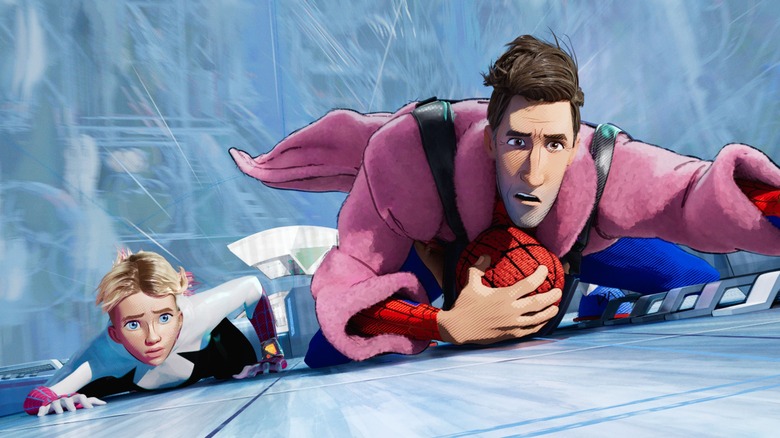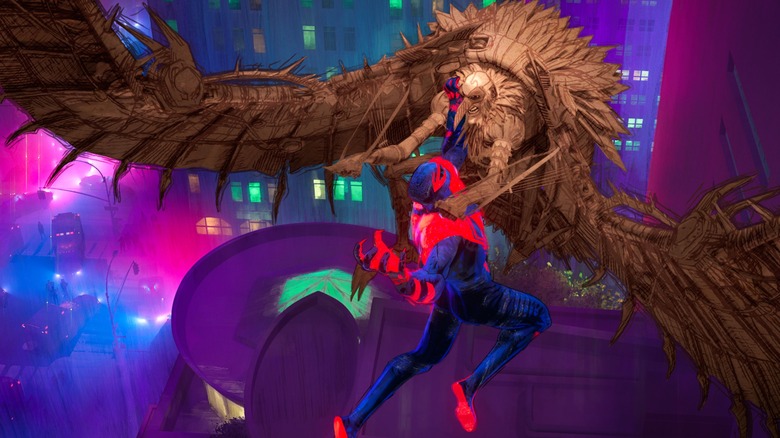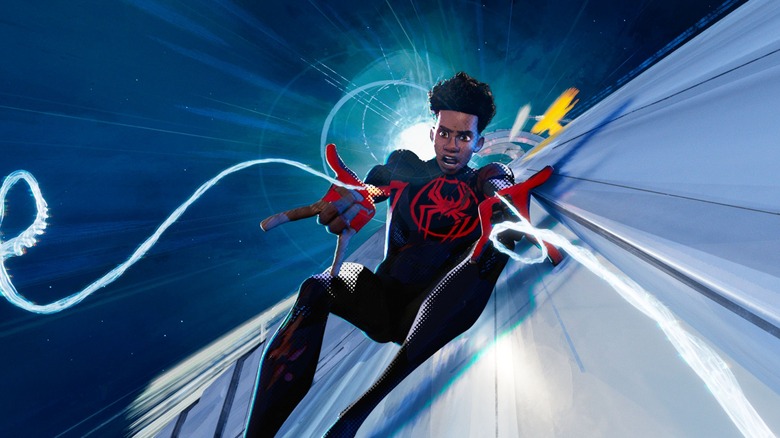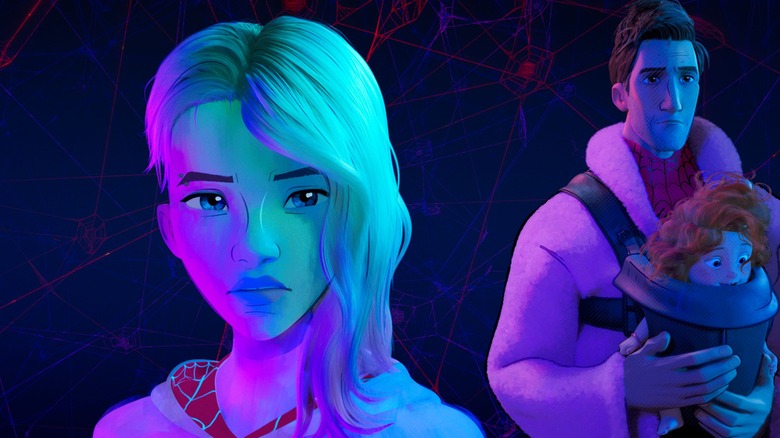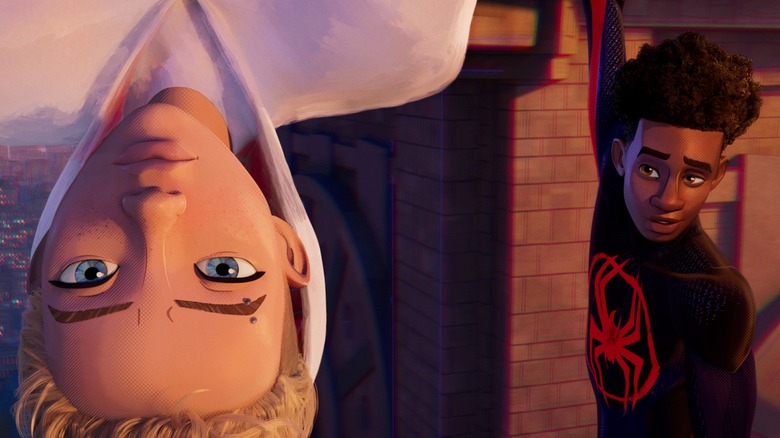Things Only Adults Notice About Spider-Man: Across The Spider-Verse
Animated movies tend to cater to children, and "Spider-Man: Across the Spider-Verse" is no different. Every frame captures the childhood wonder of reading comics for the first time, and there are plenty of moments that will make kids across the globe light up with excitement. But the movie's creatives seem to thoroughly understand that good animation can stretch across age groups to offer something for everyone. The movie may be a raucous, colorful experience for kids, but adults will get even more out of it.
As Miles Morales (Shameik Moore), Gwen Stacy (Hailee Steinfeld), and plenty of new characters return to the silver screen, they are plunged into the depths of the Spider-Verse, where Easter eggs abound, moral dilemmas are unraveled, and the very canon of the Spider-Man story is at stake. As Miles fights for a Panglossian vision where he can have the best of all possible worlds, he comes up against a new villain, The Spot (Jason Schwartzman), and ultimately must even go toe-to-toe against his fellow Spider-people to fight for what he believes is right.
Unsurprisingly, that narrative gives way to a kaleidoscope of complex themes and references that only adults will notice. There are oblique references to famous works of art, homages to the rich culture of New York City's Black and immigrant communities, and heavy subtexts that explore the perils of parenting and queer identity. All of it adds up to a movie full of adult themes that belie its PG rating.
The many visual art references
Because "Spider-Man: Across the Spider-Verse" is operating at the highest levels of animation with a mix of visual styles, its creators clearly know their stuff when it comes to art. Scattered across the film is a myriad of references to artists throughout history, from Renaissance masters to contemporary stars.
The scene packed with the most art references comes near the start of the film when Gwen's Spider-Woman fights a Leonardo Da Vinci-themed version of the Vulture inside the Guggenheim Museum, a historic art museum on the Upper East Side of Manhattan. Designed by influential architect Frank Lloyd Wright and built in 1939, the museum has displayed works by everyone from Pablo Picasso to Jean-Michel Basquiat.
Aside from the Da Vinci universe Vulture, himself a reference to the High Renaissance artist's elaborate designs for futuristic machines, his fight with Spider-Woman ends up damaging a lot of world-famous art. At one point, their fight slices a giant sculpture of a balloon dog in half. The sculpture clearly references the work of Jeff Koons, whose iconic "Balloon Dog" sculptures have made their way into prestigious museums and galleries across the world. But the destruction of the Koons dog in "Across the Spider-Verse" is even more layered. It references a real-life incident from February of this year in which one of Koons' dogs was shattered to pieces while on display at the Art Winwood in Miami.
At the end of the fight, Gwen, Jessica (Issa Rae), and Miguel (Oscar Isaac) stop a falling helicopter by suspending it in webbing. A random Guggenheim visitor remarks, "Yeah, I think it's a Banksy." The line is a callback to "Spider-Man: Into the Spider-Verse" and references the anonymous English street artist Banksy, known for his confrontational guerrilla street art.
Hip-hop and graffiti culture
Both in "Spider-Man: Across the Spider-Verse" and its predecessor, "Spider-Man: Into the Spider-Verse," hip-hop culture has been at the forefront of Miles Morales' style. It's perfectly fitting for the first Afro-Latino Spider-Man since hip-hop is an art form with New York City's Black and Puerto Rican communities firmly at its center.
Hip-hop consists of pillars famously laid out by Afrika Bambaata: DJing, MCing, breakdancing, graffiti, and according to some, knowledge. Miles embodies all five of those elements. He's a prolific graffiti artist and was even bitten by the spider that gave him powers while in the process of graffitiing a wall. In "Across the Spider-Verse," we see that he's also painted a beautiful tribute to his late Uncle Aaron (Mahershala Ali) on a wall near the Morales family's apartment.
When it comes to DJing and MCing, Miles' taste in music is reflected onscreen and in the soundtrack, curated this time around by hip-hop producer Metro Boomin and featuring multiple generations of legendary New York City rappers, from Nas to A$AP Rocky. Miles even has a poster of the latter's 2013 album, "Long. Live. ASAP." hanging next to his bed. Those two rappers are significant to Miles Morales, who hails from Brooklyn like Nas but finds himself living in A$AP's neighborhood of Harlem in other "Spider-Man" stories.
DJing is the backbone of hip-hop culture. Hip-hop emerged from Afro-Latino and Caribbean dance halls, where a DJ would spin vinyl breakbeats while an MC talked over the music, encouraging the crowd to let loose. At Jefferson Morales' party, a DJ is scratching vinyl, paying homage to that history.
Finally, Miles' movements as Spider-Man are reflective of breakdancing. His moves while swinging and fighting resemble famous breakdancing moves like the windmill and airflare.
The struggles of parenting
"Spider-Man: Across the Spider-Verse" focuses heavily on the relationships parents have with their children. While Miles Morales hides his heroism from his parents, Gwen's dad finds out about hers near the beginning of the film. And when Peter B. Parker (Jake Johnson) shows up, he's got a toddler in tow. Parenting and its exigent struggles are one of the film's core themes.
Although the story is told from the point of view of its young heroes, it doesn't shy away from placing equal weight on the emotions of their parents. Gwen and Miles both want their parents to love and support them regardless of who they are, and although their parents have their best interests at heart, they struggle to find the right balance.
As all three sets of parents come to learn, there's no one-size-fits-all approach to raising a child. Jefferson and Rio Morales (Brian Tyree Henry and Luna Lauren Velez) are pulled apart over their different parenting philosophies, with Jefferson erring on the side of tough love and Rio hoping that Miles will open up to her if she lets him be himself.
In another universe, George Stacy (Shea Whigham) discovers that his daughter Gwen is Spider-Woman, who he has been working tirelessly to apprehend since he wrongfully believes she killed her friend Peter (Jack Quaid). At first, he's unwilling to accept her, but he ultimately chooses to accept his daughter, declaring parenting to be a mystery.
Finally, we have Peter B. Parker, who tells Miles that he only had his daughter because he hoped she'd turn out like him. Peter is overwhelmed by the joy of new fatherhood but terrified he'll screw it all up. Fear for their children's unknown future weighs heavily on all parents in the film.
Vintage Spider-Man
During the chase scene toward the middle of "Spider-Man: Across the Spider-Verse," in which Miles attempts to escape the clutches of the Spider Society, there are too many Spiders to count, but we know they number in the hundreds due to a comment from Miles.
Young people who have done their Spider-Man homework may well have recognized many of the various Spiders who appeared in Miguel O'Hara's Spider Society. But if you're old enough that sleeping in the wrong position screws your back up for a week, you probably caught a blast of nostalgia seeing Spider-Men from the pre-Y2K era.
The oldest Spider-Man we've noticed is the version from the 1967 animated TV series, which modern audiences will remember best for its iconic theme music, versions of which have been remixed for multiple interpretations of the character since. The first animated "Spider-Man" series had a notoriously limited budget, leading the character to be woefully under-animated without the spider web patterns on his costume. He's also the source of many current-day internet memes, most famously the "Spider-Man pointing" meme that was referenced in one hilarious moment during the chase sequence in "Across the Spider-Verse," as well as in "Spider-Man: No Way Home."
We also see Ben Reilly, aka Scarlet Spider, who shows up several times in the film, most notably when the Spider Society sends its operatives to Miles' universe. The character first debuted in 1975 on the pages of "Amazing Spider-Man #149." Then there's the Spider-Man wearing a paper bag over his head. That's the Bombastic Bag-Man, who first appeared in "Amazing Spider-Man #258" in 1984.
Gwen and Miles have queer subtexts
After seeing "Spider-Man: Into the Spider-Verse," many LGBTQIA+ fans were pleasantly shocked by how relatable it felt to their own experiences. Of course, this isn't the first time superheroes have acted as allegories for queerness. Fox's "X-Men" films leaned hard on that allegory back in the late 2000s, after all. But in "Across the Spider-Verse," the subtext isn't exactly subtle.
Transgender Spider-Man fans have already noted that in "Across the Spider-Verse," Gwen Stacy's arc is heavily coded to evoke trans experiences. Not only does she have a trans pride flag bearing the slogan "protect trans kids" on her bedroom wall, but when she tells her dad how hard it is to hide half her identity from him and others, the entire scene becomes awash in the pastel pink, blue, and white of the trans flag.
Meanwhile, Miles has another relevant problem, in that he can't quite bring himself to come out to his parents as Spider-Man. Any queer person who grew up in the closet can certainly relate to that dilemma. It is unbearable to think that your parents might not accept who you truly are, and though it seems easy to keep the truth hidden, bottling it up inside often leads to an infinitude of emotional pain and turmoil.
"Spider-Man: Across the Spider-Verse" was burdened by the prestige of its predecessor, which won an Academy Award and has inspired a new wave of experimental animation styles from other studios. Nevertheless, it delivered spectacularly, proving that animation can cater to people of all ages, from all walks of life.
